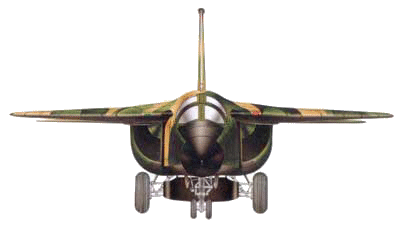|

General Dynamics F-111

The first warplane with variable
geometric wings to be mass produced, the F-111 was built by General
Dynamics at the beginning of the 1960s against an initial contract for
delivery of eighteen planes to the USAF and five to the US Navy. Although
the prototype had already flown on December 21, 1964, subsequent phases of
development were fraught with difficulties, leading to the abandonment of
the program by the US Navy. Production, therefore, was reserved for the
USAF, which took delivery of the first machines in 1968. The first variant
was the F-111A, and after seventeen pre-production models, 141 of these
planes were built. Then followed 76 FB-111As, with more powerful engines,
larger wings and more sophisticated electronics, which went into service
in 1969. Successive variants were the E (94 planes in service from
September 1970); the D for tactical support (96 machines, operational from
October 1971); and the F, the final version which appeared as prototype in
May 1973 and of which 106 were made, the last in November 1976. Total
production of General Dynamics F-111 was 562 aircraft, including 24
F-111Cs which were exported to Australia.
The first F-111As, hot off the assembly
lines, were sent to Vietnam in March 1968 for the Combat Lancer operation.
Six tactical bombers of the 428th TFS had the chance to prove their worth
in the battle zone, but the experiment was disastrous: three of the six
were destroyed during unescorted missions at various times. Initially it
was assumed they had been shot down by the enemy, but it later became
clear that they had crashed because of structural faults. The detachment,
having carried out 55 missions, was recalled to the US, where criticism of
this already controversial aircraft reached a new peak. Yet the F-111A did
eventually prove itself, again in Vietnam. On September 27, 1972, 48
F-111As of the 429th and 430th TFS of the 474th TFW arrived in Southeast
Asia; they immediately went into action to help check the accelerating
advance of the North Vietnamese. In five months, that is up to the end of
the hostilities, they carried out over 4,000 sorties dropping about 74,000
tons of bombs with high results, and the loss of only six machines. It is
worth noting that 3,980 of these 4,000 missions were effected by means of
TFR (Terrain Following Radar), a radar system capable of guiding the plane
at a height of only a few meters, encompassing the slightest unevenness of
terrain, without intervention by the pilot, and flying beneath the net of
the SAM missile radar systems. Such feats in Southeast Asia were crucial
in establishing and later restoring the reputation for quality which this
variable-sweep wing fighter-bomber from General Dynamics was intended to
possess from the start. In action once more in April 1986, attacking
targets in Tripoli and Benghazi, Libya, the F-111s confirmed their right
to be considered the spearhead of the USAF tactical bombing operations.



Technical Specifications
Aircraft:
General Dynamics
F-111A
Year: 1964
Type: fighter-bomber
Manufacturer: General Dynamics
Engine: 2 x Pratt & Whitney TF30-P-1
Power: 18,000 lb (8,165 kg)
Wingspan: 63ft (19.20m)
Length: 73ft 5 1/2in (22.40m)
Height: 17ft 1/2in (5.18m)
Wing area: 525sq ft (48.77mē)
Max take-off weight: 98,850 lb (44,838 kg)
Empty weight: 46,172 lb (20,944 kg)
Max speed: 1,435mph at 53,450ft (2,338km/h at 16,292m)
Service ceiling: 56,650ft (17,267m)
Range: 1,330mi (2,140km)
Crew: 2
Load-armament: 1x20mm cannon; 30,000 lb (13,608 kg)
|
